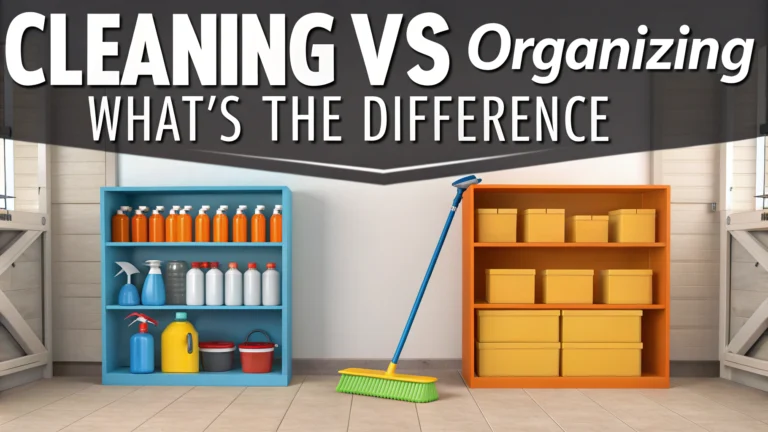Many people mix up **cleaning** and **organizing**, thinking they’re the same activity. **Cleaning** focuses on removing dirt, dust, and grime, while **organizing** involves creating functional systems and proper item placement.
A well-maintained space needs both activities, but knowing the difference helps create more effective home management routines. Understanding these distinct processes allows for better time management and more lasting results.
Key Differences Between Cleaning and Organizing
| Cleaning | Organizing |
|---|---|
| Removes dirt and germs | Creates systems and order |
| Regular maintenance | One-time setup with periodic updates |
| Focus on surfaces | Focus on space utilization |
Essential Cleaning Tasks and Their Frequency
- **Daily Tasks**: Dishes, wiping counters, quick bathroom wipe-down
- **Weekly Tasks**: Vacuuming, mopping, dusting
- **Monthly Tasks**: Deep cleaning appliances, washing windows
- **Seasonal Tasks**: Carpet cleaning, window washing, gutter maintenance
Core Organizing Principles and Methods
- **Categorization**: Group similar items together
- **Zoning**: Assign specific areas for different activities
- **Accessibility**: Place frequently used items within easy reach
- **Container System**: Use appropriate storage solutions
> “The difference between cleaning and organizing is like the difference between washing your car and tuning the engine – both are necessary but serve different purposes.”
The Essential Difference Between Cleaning and Organizing
Understanding how **cleaning** and **organizing** differ helps create better home management systems. These two tasks require different approaches, tools, and mindsets for maintaining a functional living space.
Setting Up Your Cleaning Schedule
A well-structured cleaning routine prevents tasks from becoming overwhelming. Break down cleaning into:
- **Daily**: Quick wipe-downs, dishes, bed-making
- **Weekly**: Vacuuming, bathroom deep clean, dusting
- **Monthly**: Appliance maintenance, window cleaning
Organizing Methods That Work
Creating functional organization systems requires:
- **Zones**: Designate specific areas for different activities
- **Categories**: Group similar items together
- **Access**: Place frequently used items within reach
Tools and Supplies for Each Task
| Cleaning Tools | Organizing Tools |
|---|---|
| Multi-surface cleaners | Storage containers |
| Microfiber cloths | Label maker |
| Vacuum cleaner | Drawer dividers |
Problem Areas and Solutions
Focus on common trouble spots:
– Kitchen counters: Use clear containers for frequently used items
– Entryway: Install hooks and shoe storage
– Bathroom: Add drawer organizers and over-door storage
Maintaining Clean and Organized Spaces
Follow the “**one-in-one-out**” rule when bringing new items home. Regular **15-minute tidying sessions** prevent clutter buildup and maintain cleanliness.
Time Management Strategies
Break tasks into manageable chunks:
– Morning: Quick clean of high-traffic areas
– Evening: 10-minute organizing session
– Weekend: Deeper cleaning tasks
Building Long-term Habits
Start with small changes and build consistency. Track progress using a simple checklist system and adjust methods based on what works for your lifestyle.
> “A place for everything and everything in its place creates both a clean and organized home.”
Remember to focus on progress rather than perfection when developing new cleaning and organizing habits.
Frequently Asked Questions About Cleaning vs Organizing
Q: What’s the main difference between cleaning and organizing?
Cleaning involves removing dirt, dust, and grime, while organizing focuses on creating systematic arrangements and proper storage solutions. Cleaning is about hygiene, while organizing is about order and efficiency.
Q: Should I clean or organize first?
Always organize before deep cleaning. Remove clutter and arrange items first, then clean the cleared spaces. This prevents having to move items multiple times and makes cleaning more efficient.
Q: How often should you clean versus organize?
General cleaning schedule:
- Daily: Basic tidying
- Weekly: Regular cleaning
- Monthly: Deep cleaning
Organizing should be done:
- Seasonally: Major spaces
- Yearly: Complete home organization
Q: What are the basic tools needed for cleaning vs organizing?
Cleaning essentials:
- All-purpose cleaner
- Microfiber cloths
- Vacuum cleaner
Organizing essentials:
- Storage containers
- Labels
- Drawer dividers
Q: How long does a complete house cleaning versus organizing take?
A thorough house cleaning typically takes 2-3 hours for a medium-sized home. Complete house organization can take 2-5 days depending on home size and clutter level.
Q: Can you maintain organization without regular cleaning?
No, organized spaces require regular cleaning to remain functional. Dust, dirt, and grime can make organized systems less effective and harder to maintain.
Q: What’s the ROI of professional organizing vs professional cleaning?
Professional cleaning services typically cost $25-50 per hour with immediate but temporary results. Professional organizing services ($50-150 per hour) create lasting systems that save time and money long-term.
Q: How does cleaning and organizing affect mental health?
Both activities reduce stress and anxiety, but in different ways. Cleaning provides immediate satisfaction and hygiene benefits, while organizing reduces long-term stress through improved functionality and efficiency.
Q: What are the steps to maintain both a clean and organized home?
1. Create designated spaces for items
2. Implement a “one in, one out” rule
3. Follow a daily cleaning schedule
4. Do weekly organization touch-ups
5. Perform monthly system evaluations
Q: Which spaces need more cleaning vs organizing?
High-cleaning areas:
- Bathrooms
- Kitchen
- High-traffic floors
High-organizing areas:
- Closets
- Home office
- Garage



















